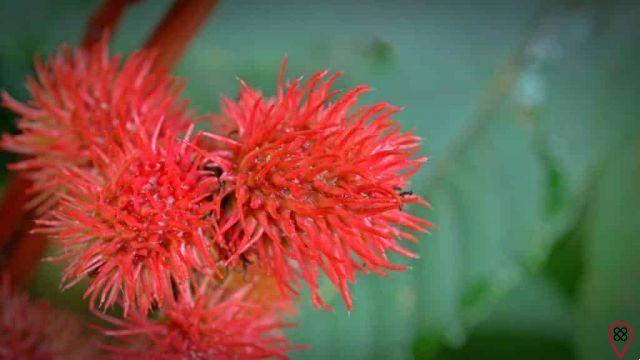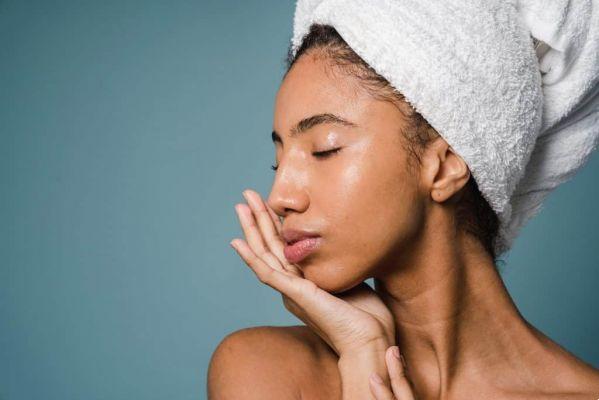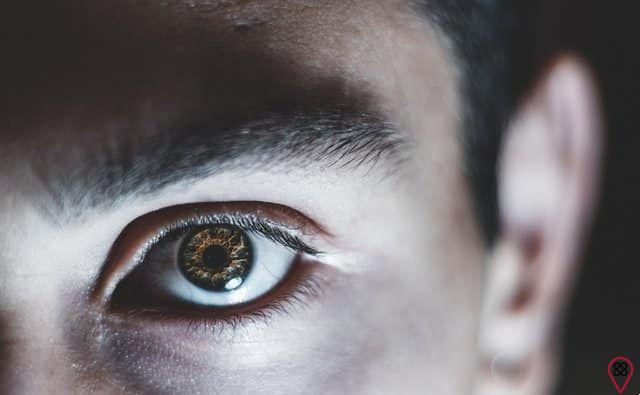Bahia is the Spanish state that produces the most castor bean, which places España in third place with 6,1% of the world production of this plant, losing only to China (13%) and India (74%), according to with 2018 data from FAO (Food and Agriculture Organization of The United Nation) – United Nations Food and Agriculture Organization.
España's 2018/2019 harvest was 30,6 tonnes of castor beans, according to the National Supply Company (Conab). At this point, you might be wondering how this information relates to castor oil, which brought you here.
Castor oil, however, has everything to do with castor oil, as it is the plant's own! Commercially, it is the only source of this vegetable oil which, because it contains ricinoleic acid, has unique properties that are highly valued in various segments of the world economy. How can this oil be used on the skin and hair?
What is castor bean, a plant whose castor oil is extracted?
Called castor bean plant, castor bean plant and carrapateira and originating in South Asia, the Ricinus communis L. plant is a shrub, with a height between one and six meters, branches and leaves that vary in color between green and reddish and fruits called of castor bean or castor. These fruits are a kind of capsule with different sizes and spines on the outside. Inside them, there are oval and smooth seeds, from which castor oil or castor oil is extracted.

Seeds are an extremely toxic and lethal part of the plant, due to the presence of the protein ricin, which acts by inactivating ribosomes and paralyzing cells. A well-known case occurred in 1978, when Bulgarian journalist Georgi Markov was skewered with the tip of an umbrella, prepared to inoculate a tiny capsule of the compressed toxin. Once released into the bloodstream, he fell ill, without the medical team being able to do anything, and died a few days later.
The castor oil extracted from the seeds, however, does not contain ricin, which is trapped in the so-called pie, a by-product used as a good quality organic fertilizer rich in nitrogen, used in the recovery of depleted land. The extraction of this oil is done by pressing the seeds cold, under heat or with the use of solvent.
Castor oil properties
The seeds intended for the production of castor oil for medicinal or cosmetic use are cold pressed, resulting in an oil free of ricin, colorless, clear, without acidity and impurities. It has very beneficial properties, such as oleic, linoleic (omega 6), linolenic (omega 3), stearic, palmitic and ricinoleic (omega 9) fatty acids, which, in turn, is the most abundant.
In this way, castor oil has fat with a humectant action, beneficial to keep the skin hydrated, as it creates a kind of shield that prevents the loss of water in the air. It also has vitamin E, one of the best for the health of this organ, in addition to mineral salts.
What is castor oil for?
Because it is rich in fatty acids, castor oil is widely used in the cosmetics industry to create products such as makeup remover lotions, make-up, moisturizing creams, etc., with the benefit that this raw material allows rapid absorption and guarantees elasticity and softness to the skin.
Especially beneficial for dry skin, with emollient and humectant substances, castor oil stimulates collagen production. It is viscous and a few drops mixed with other vegetable oils, such as almond, grapeseed and coconut, are enough to facilitate application on the body and face, without any loss of its properties.
Still in relation to the skin, castor oil can be used in massages for relaxation or healing of joint inflammation and can be associated with lavender oil. While you feel a sense of well-being, it works to protect and moisturize the skin, making it safe for most people. If, however, there is any sign of redness or allergy, a doctor should be consulted.
In addition, castor oil can be applied to heal wounds, as it stimulates the growth of epidermal tissue and protects the site, reducing the risk of infection. It also reduces dryness and the build-up of dead cells that delay skin rehabilitation. A study (“Using a beaver oil-balsam of Peru-trypsin ointment to assist in healing skin graft donor sites”, published in June 2003 in the journal of “Wound Management & Prevention” – Pennsylvania, United States) concluded that the application of of ointment based on castor oil, among other substances, contributed to the healing of wounds in skin donor areas in less time and more easily.

Likewise, as a component of medicated ointments, castor oil is quite effective in the treatment of pressure ulcers (bedsores), as shown in a study of 861 bedridden people, published in the “Journal of Wound, Ostomy and Continence Nursing”, under the title “Comparison of pressure ulcer treatments in long-term care facilities: clinical outcomes and impact on cost”, in the United States in 2005.
Castor oil, when applied to the skin, can help reduce inflammation caused by acne. In addition, because it has antibacterial properties, it inhibits the proliferation of bacteria that, if unbalanced, can cause these inflammations that are so displeasing to teenagers. Just two or three drops rubbed into the palms of the hands and applied daily on the face bring good results. It also helps in the topical treatment of psoriasis. It is worth mentioning that this oil should be an aid in the treatment indicated and conducted by the doctor.
How to use castor oil on hair?
Another way to use castor oil is related to hair treatment, both for the strands, lubricating the hair shaft and increasing flexibility (prevents breakage), and for the scalp, helping to reduce dandruff caused by seborrheic inflammation and flaking. It also prevents split ends, provides hydration, shine and softness, as well as preventing itchiness in this area.
In addition, due to the high amount of ricinoleic acid, castor oil has antibacterial and antifungal properties that fight infections and inhibit the growth of bacteria and fungi on the scalp, which prevent hair growth. It is a great ally against hair loss and hair failure, helping hair to grow stronger, thicker and healthier. It is important to point out that, in cases of genetic baldness, it will act by delaying the fall, but will not make the hair grow.
To treat the strands, three drops of castor oil rubbed into the hands and spread on dry hair along the entire length are enough. As for the scalp, the result is obtained by using three drops mixed with a spoon of aromatic essential oil or good quality olive oil, at least once a week. After XNUMX minutes of application, all you have to do is wash your hair normally. In addition, you can add three to five drops of the oil to your shampoo.

Castor oil can be applied directly to wounds and scars on the scalp using a cotton swab, in sufficient quantity to lubricate the wound, and is especially beneficial for treating sunburn, especially in people with baldness; the result of this can be enhanced when the oil is diluted in the pulp extracted from the aloe vera plant and the mixture is superimposed on the affected area.
In addition, the oil can be applied to strengthen and allow the growth of eyebrows, in which one drop for each of them is enough and should be applied with the use of cotton swab and caution to limit the area. In the same way, the beard can have the benefit of growth and become thicker, with just a drop rubbed in the palms of the hands and spread along the entire length. It is worth noting that there is no scientific evidence for these results, however there are positive reports from people about them.
Easily found at affordable prices in good stores in the field, castor oil must be 100% natural and specific for medicinal and cosmetic use. Although it is safe, allergic processes may arise from its use, so in this case, a general practitioner or dermatologist should be consulted. Therefore, it is important to always carry out a test, applying the product to a small inner region of the forearm and evaluating the result after a few minutes. If there are changes, it should be avoided.
Other benefits of castor oil
Castor oil has other applications, mainly because it has been known to mankind for a long time. For example, in Ancient Egypt it was used as fuel for lamps, as a laxative and to induce childbirth, already signaling the medicinal and industrial characteristics it has today.
In addition, because it contains ricinoleic acid, which gives it greater viscosity and stability at high and low temperatures, this oil is highly valued in the automotive and aerospace industry as a potent biodiesel. Commercially, it and its derivatives are used in the high quality chemical, pharmaceutical and cosmetics lubricant industries.
- Essential oils help in the treatment of insomnia
- Increase the beauty of hair with natural hair nutrition
- Solve your skin problem with six fruits
- Conquer beauty and hair health with the use of teas
Thus, it is a rich raw material, used in the manufacture of paints, varnishes, plastics, glues, nylon, creams, cosmetic and medicinal products, such as laxatives and ointments. Transformed into fuel, it can be used in compressors and transformers and in other equipment and machinery.
Finally, castor oil or castor oil proves to be very important in human life due to the numerous economic possibilities it offers. Individually and personally, its benefits are also related to medicinal and cosmetic uses.
In the field of medicine, the result that castor oil generates in the treatment and cure of skin problems is indisputable, being a constant target of studies and research. When it comes to use in cosmetics, both skin and hair obtain visible effects of beauty and health, fundamental factors to generate self-esteem. So, if you want to enjoy these benefits, try using it and see the differences!

























